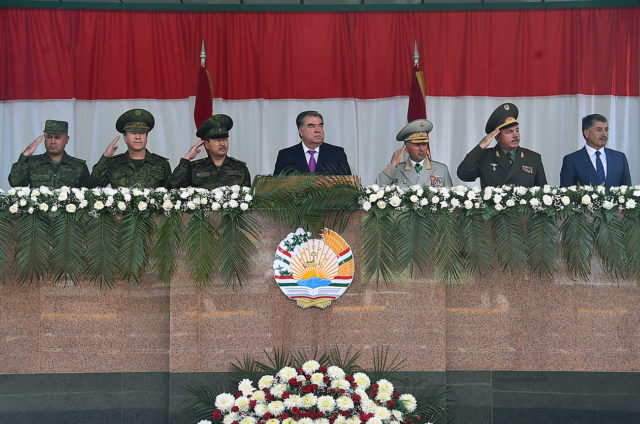
Tajiks on Afghan Border Mobilize Against Dushanbe’s Plans for a Crackdown
Publication: Eurasia Daily Monitor Volume: 15 Issue: 148
By:

Tajikistan’s isolated Gorno-Badakhshan Autonomous Oblast, which adjoins Afghanistan, is rapidly descending into chaos. Dushanbe has demanded that the population turn in its weapons, leading to clashes between locals and the estimated 7,500 Tajikistani soldiers stationed there. Remarkably, and in an unprecedented step, residents have launched an online petition, calling on the central government to negotiate rather than send more military forces to Gorno-Badakhshan (Change.org, October 13).
This mountainous region of 200,000 people has long been among the most restive in that Central Asian republic, repeatedly the object of military operations and central government demands for disarmament. But the situation has deteriorated significantly following a mid-September visit to Khorog, the oblast’s capital, by Tajikistan’s President Emomali Rahmon, who denounced local officials for failing to put things in order (Fergananews.com, September 25). He threatened to purge the local officials if they did not disarm the population and declared he would send in the army to do so if the officials did not. He also denounced the local establishment for allowing the free flow of drugs through the region and for failing to counter the spread of alcoholism.
Shodikhon Dzhamshid, the head of the autonomy at that time, said he would restore order—but only after the Commonwealth of Independent States (CIS) summit in Dushanbe occurred (it took place on September 27), lest a clash there embarrass President Rahmon. The situation has nevertheless remained tense, with repeated armed clashes between the population and the Tajikistani military. Almost anything, the Fergana news agency says, could now “provoke a major conflict,” lead to a revolt by residents of that long-restive region and/or to the entrance into Gorno-Badakhshan of radical Islamists and drug traffickers from Afghanistan. That, in turn, could open the way for the spread of violence northward into the rest of Central Asia. Such an explosion cannot be excluded now that the October 16 deadline Rahmon set during his visit to the region for cleaning house has passed.
Since the beginning of October, in hopes of quelling resistance and restoring central control, Dushanbe has replaced the governor and most of the members of his regime. It has also called for residents to turn in their arms, promising an amnesty if they do. But according to one report, only about 100 people have done so, a small fraction of the number with weapons. That report also claims there had been only one case of violent resistance—but again, the isolation of this region means that the number of incidents almost certainly has been larger and will grow if the Tajikistani authorities continue to press for disarmament (News.tj, October 9).
Perhaps the most intriguing aspect of the ongoing developments in Gorno-Badakhshan is that residents there, together with people from the region who have moved to lowland areas, are not simply engaging in anomic and disordered violence; rather, they are seeking to force Dushanbe to negotiate with them. They have many grievances, their online petition suggests. And if the central government does not meet them at least part way, they are implicitly threatening to use force either on their own or together with Islamists and drug dealers from Afghanistan.
The people of Gorno-Badakhshan cannily cast their appeal as a way of supporting Rahmon, but in fact, their complaints and proposals are about reining in Rahmon’s military, special forces and police. Residents assert that the Tajikistani siloviki (security services) are openly flaunting the law and the constitution, accusing local people of crimes they have not committed, and engaging in activities that raise questions as to whether they are, in fact, are in cahoots with drug dealers and Islamists either from the region or from Afghanistan. Moreover, the authors of the appeal say that this situation has continued since at least 2012, the last time Dushanbe conducted a crackdown in Khorog and surrounding areas (see EDM, July 27, 2012), sparking doubts about the competence and control of the law enforcement and military bodies of the republic (Fergananews.com, October 15).
Lest the situation deteriorate further, the appeal says, there is a need to take a number of steps, including two that might contribute to stability but that are unlikely to be accepted by the central government. On the one hand, the appeal’s authors want the formation of a commission composed of representatives of the regime and the local population to oversee the situation and ensure that the siloviki do not violate the law or exacerbate the situation by making inappropriate statements to the media. And on the other hand, they call for bringing in representatives of the Organization for Security and Cooperation in Europe (OSCE) to oversee the work of the commission and to ensure that the language and cultural rights of the various nations of Gorno-Badakhshan are respected—something they suggest is not the case at present.
Such civic activism is unlikely to be accepted by Rahmon, who undoubtedly will view it not as a solution but as a threat to his power and position. And he has good reasons to fear that: The ability and willingness of Gorno-Badakhshan’s people to make use of the Internet to press their case in Dushanbe suggests that they are far better organized and thus potentially a far more dangerous opponent than they were during Tajikistan’s civil war in the 1990s or even in 2012. Consequently, if Rahmon does move against them—as seems likely—a new, more organized and quite possibly more violent resistance could emerge on the already tense border with Afghanistan.



